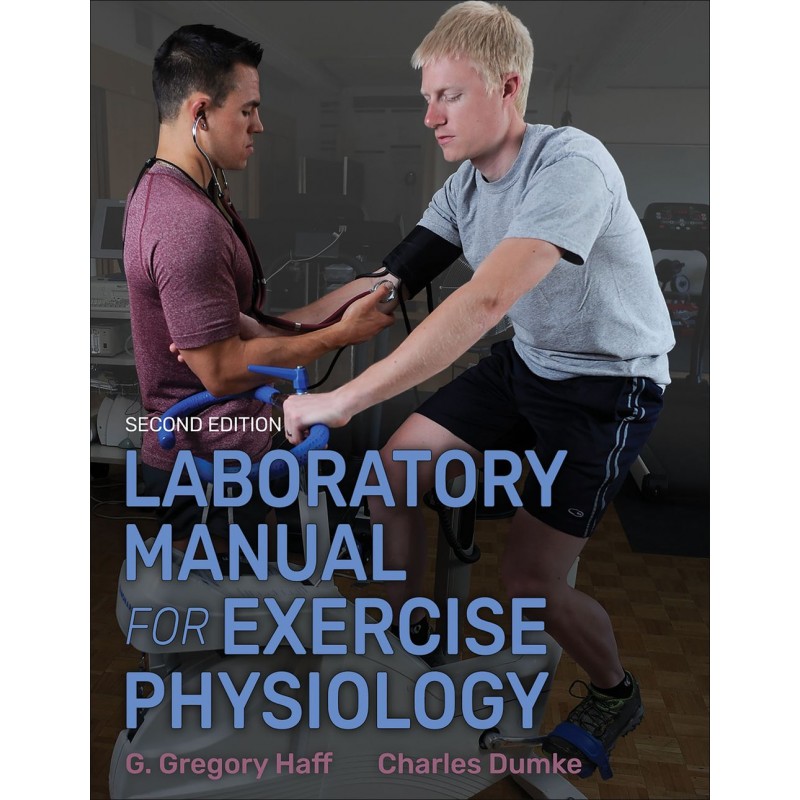- Reduced price

Order to parcel locker

easy pay


 Delivery policy
Delivery policy
Choose Paczkomat Inpost, Orlen Paczka, DHL, DPD or Poczta Polska. Click for more details
 Security policy
Security policy
Pay with a quick bank transfer, payment card or cash on delivery. Click for more details
 Return policy
Return policy
If you are a consumer, you can return the goods within 14 days. Click for more details
Data sheet
Laboratory 1. Primary Data Collection
Test Variables
Measurement Terminology
Metric Conversions
Background and Environmental Information
Descriptive Statistics
Presentation of Results
Interpretation of Data
Laboratory Activity 1.1: Basic Data
Laboratory Activity 1.2: Statistical Procedures
Laboratory Activity 1.3: Tables and Graphs
Laboratory 2. Pretest Screening
Informed Consent
Physical Activity Readiness Questionnaire for Everyone
Health History Questionnaire
Signs and Symptoms of Disease and Medical Clearance
Coronary Risk Factor Analysis
Lifestyle Evaluation
Disease Risk Stratification
Laboratory Activity 2.1: Basic Screening Procedures
Laboratory Activity 2.2: Pretest Results
Laboratory 3. Flexibility Testing
Direct and Indirect ROM Assessment
Body Areas
Laboratory Activity 3.1: Traditional, Wall, V-Sit, and Chair Sit-and-Reach Test Comparisons
Laboratory Activity 3.2: YMCA, Backsaver, and Goniometer Test Comparisons
Laboratory Activity 3.3: Canadian, Traditional, and Backsaver Sit-and-Reach Test Comparisons
Laboratory Activity 3.4: Shoulder Flexibility Test Comparisons
Laboratory 4. Blood Pressure Measurements
Blood Pressure Responses to Exercise
Accurate Blood Pressure Checks
Laboratory Activity 4.1: Effects of Body Position on BP
Laboratory Activity 4.2: Effects of Dynamic Exercise on BP
Laboratory Activity 4.3: Effects of Isometric Contractions on BP
Laboratory 5. Resting Metabolic Rate Determinations
Aerobic Metabolism and Respiratory Exchange Ratio
Total Energy Expenditure and RMR
Laboratory Activity 5.1: Predicting RMR
Laboratory Activity 5.2: Measuring RMR
Laboratory 6. Oxygen Deficit and EPOC Evaluations
Transition From Rest to Exercise
Oxygen Uptake During Exercise and Recovery
Laboratory Activity 6.1: Calculation of Oxygen Deficit and EPOC
Laboratory 7. Submaximal Exercise Testing
Measurement of Heart Rate
Rating of Perceived Exertion
Laboratory Activity 7.1: Submaximal Bench Step Test
Laboratory Activity 7.2: Submaximal Treadmill Test
Laboratory Activity 7.3: Submaximal Cycle Ergometer Test
Laboratory 8. Aerobic Power Field Assessments
Cooper 1.5-Mile Run/Walk Test
Cooper 12-Minute Run/Walk Test
Rockport Fitness Walking Test
Laboratory Activity 8.1: Cooper 1.5-Mile Run/Walk Test and 12-Minute Run/Walk Test
Laboratory Activity 8.2: Rockport Fitness Walking Test
Laboratory 9. High-Intensity Fitness Testing
Léger 20 m Shuttle Run Test
Yo-Yo Intermittent Recovery Test
30-15 Intermittent Fitness Test
Laboratory Activity 9.1: Léger 20 m Shuttle Run Test (20mSRT)
Laboratory Activity 9.2: Yo-Yo Intermittent Recovery Test (Yo-Yo IRT)
Laboratory Activity 9.3: 30-15 Intermittent Fitness Test (30-15IFT-40m)
Laboratory Activity 9.4: Modified 30-15 Intermittent Fitness Test (30-15IFT-28m)
Laboratory 10. Maximal Oxygen Consumption Measurements
Selecting a Test Protocol
Monitoring Progress With RPE Scales
Estimating Fuel Usage With RER
Ventilatory Threshold
Laboratory Activity 10.1: Graded Treadmill V?O2max Test
Laboratory Activity 10.2: Cycle Ergometer V?O2max Test
Laboratory 11. Blood Lactate Threshold Assessment
Determining the Deflection Point
Selecting a Test Method
Role of the Ventilatory Threshold
Laboratory Activity 11.1: Blood Lactate Measurement at Rest
Laboratory Activity 11.2: LT During an Incremental Cycle Test
Laboratory Activity 11.3: Blood Lactate After Anaerobic Exercise
Laboratory 12. Musculoskeletal Fitness Measurements
Assessments of Muscular Strength
Assessments of Muscular Endurance
Laboratory Activity 12.1: Maximal Upper-Body Strength
Laboratory Activity 12.2: Maximal Lower-Body Strength
Laboratory Activity 12.3: Maximal Handgrip Strength
Laboratory Activity 12.4: Upper-Body Muscular Endurance
Laboratory 13. Anaerobic Fitness Measurements
Sprinting Performance Tests for Estimating Horizontal Power
Jumping Performance Tests for Determining Vertical Power
Formulas for Estimating Vertical Power
Bosco Test for Estimating Power Endurance
Determining the Eccentric Utilization Ratio
Wingate Anaerobic Test for Determining Anaerobic Cycling Power
Margaria-Kalamen Stair-Climb Test for Determining Anaerobic Power
Laboratory Activity 13.1: Sprinting Performance
Laboratory Activity 13.2: Jumping Performance
Laboratory Activity 13.3: Jumping Performance With a Switch Mat
Laboratory Activity 13.4: Power Endurance
Laboratory Activity 13.5: Anaerobic Cycling Power
Laboratory Activity 13.6: Margaria-Kalamen Stair-Climb Test
Laboratory 14. Pulmonary Function Testing
Pulmonary Function Testing
Pulmonary Function Testing as a Tool for Diagnosing Pulmonary Disease
Respiratory Limitations on Exercise
Laboratory Activity 14.1: Lung Volumes and Capacities
Laboratory Activity 14.2: Pulmonary Function
Laboratory Activity 14.3: Exercise-Induced Ventilatory Limitations
Laboratory Activity 14.4: Exercise-Induced Asthma
Laboratory 15. Body Composition Assessments
Body Composition Models
BMI for Categorizing Body Composition
Circumference Measurements and Health Risk
Skinfold Thickness as a Measure of Body Fat
Laboratory Activity 15.1: BMI and Circumference Data
Laboratory Activity 15.2: Techniques for Measuring Skinfold Thickness
Laboratory Activity 15.3: Estimating Relative Body Fat Using Hydrodensitometry
Laboratory 16. Electrocardiograph Measurements
Electrical Activity of the Heart
Placement of ECG Leads
Interpreting the ECG Recording
ECG as a Tool for Diagnosing Cardiac Abnormalities
HR Response to Exercise
Laboratory Activity 16.1: Resting ECG
Laboratory Activity 16.2: Effects of Body Position on the Heart Axis
Laboratory Activity 16.3: Submaximal Exercise Effects With the 12-Lead ECG
Appendix A: Units of Measure Conversions
Appendix B: Estimation of the O2 Cost of Walking, Running, and Leg Ergometry
Appendix C: Haldane Transformation
Appendix D: Metabolic Cart Information
Appendix E: Calibration of Equipment
Appendix F: Certifications in Exercise Science
Reference: 41464
Author: Janet G. Travell
Volume 1: Upper Half of Body
Reference: 44190
Author: Roger Watson
